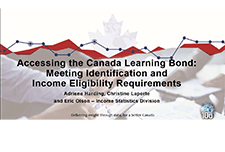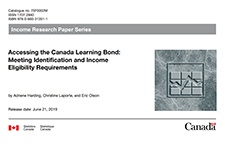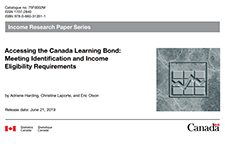Discover financial empowerment resources
Discover financial empowerment resources
This webinar shares results on Statistics Canada research on barriers to uptake for the Canada Learning Bond (CLB). Specifically, this research examines whether tax filing or Social Insurance Number (SIN) access are greater barriers to accessing the CLB. Read the slides which accompany this...

Not having a Social Insurance Number (SIN) and not filing taxes may represent challenges to access government programs and supports such as the Canada Education Savings Grant (CESG) and the Canada Learning Bond (CLB). Limited data availability has prevented a full assessment of the extent of these...

Introduced in 1998, the Canadian Education Savings Program (CESP) was designed as an incentive to encourage education savings for the post-secondary education of a child. The program is centred on Registered Education Savings Plans (RESPs), where savings accumulate tax-free until withdrawn, to pay...

